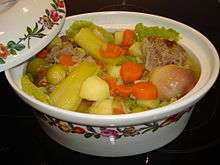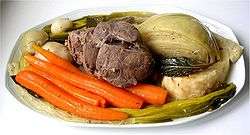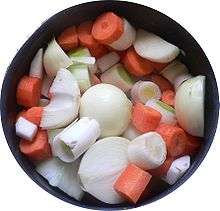Pot-au-feu
|
A French pot-au-feu | |
| Type | Stew |
|---|---|
| Place of origin | France |
| Main ingredients | Beef, vegetables (carrots, turnips, leeks, celery, onions), cartilaginous meat (oxtail, marrowbone) |
|
| |

Pot-au-feu (French pronunciation: [pɔ.to.fø] "pot on the fire") is a French beef stew. According to the chef Raymond Blanc, pot-au-feu is "the quintessence of French family cuisine, it is the most celebrated dish in France. It honours the tables of the rich and poor alike."[1][2]
Origin and history
It is difficult to know when the name pot-au-feu first appeared and when its meaning changed to describe the dish instead of the pot in which it is cooked. While pot was used to describe the rounded pot to cook on the fire at least since the 11th century (even in English),[3] there seems to be no written trace of pot-au-feu until 1673.[4]
In 1600, King Henry IV of France (1553-1610) declared, "I want no peasant in my kingdom to be so poor that he cannot have a poule au pot on Sundays."[5] Poule au pot literally means "chicken in the pot" and the so-called traditional recipe resembles the one of "pot-au-feu".[6] However, peasants' food was mainly based on bread (c. 500 g/day), root vegetables, in-season vegetables and soup. They rarely ate meat except salted pork, hog-grease, bacon, or other meat for religious celebrations (or when they dared illegally hunting on their Lord's land). For people in town, it was easier to buy inexpensive pieces of meat, which needed long cooking.
The method of cooking all food together and for extended periods of time (the whole day sometimes) gave what was called a "pot-pourri" in French and imported into English in the early 17th century.[7] The relation between pot-pourri and pot-au-feu was attested in 1829 in the Etymologic dictionary of the French language: "Pot pourri. The name our fathers gave to the pot-au-feu".[8]
Main ingredients
The cuts of beef and the vegetables involved vary, but a typical pot-au-feu contains:
- inexpensive cuts of beef that require cooking for long periods;
- some kind of cartilaginous meat, such as oxtail and marrowbone;
- vegetables: mainly root vegetables like carrots, turnips, celery, onions but also white cabbage and leeks;
- spices: bouquet garni, salt, black pepper and cloves.
Cooking cartilaginous meat in the stew will result in gelatin being dissolved into the broth. If the stew is allowed to cool, the broth may turn into a jelly, resulting in an interesting texture. Allowing the stew to cool also allows the removal of excess fat, which floats on the surface and solidifies. In order to give the broth a slightly smoked taste and its typical brown color, onions are cut in half then charred in a frying pan protected by aluminum foil until the onion's surface is completely black. The cloves are driven into the onions so that both onions and cloves can be removed easily before serving.
Serving
Traditionally, the broth is served first with a bit of nutmeg and the marrow (if a marrowbone was used) spread on toasted bread. Then the meat and the vegetables are served with coarse salt and strong Dijon mustard, horseradish sauce, and sometimes also with gherkins pickled in vinegar.
Pot-au-feu broth may also be used as a soup (often enriched with rice, pasta or toasted bread), as a base for sauces, or for cooking vegetables or pasta. Ready-to-use concentrated cubes are available to make what purports to be pot-au-feu broth when water is added.
Variants
Many countries have similar dishes with local ingredients. Even within France, ingredients may differ from one region to another and with the season.
See also
| Wikibooks has a book on the topic of: Cookbook:Pot-au-feu |
References
| Wikimedia Commons has media related to Pot-au-feu. |
- ↑ "Vive La France!" (PDF). Observer Food Monthly. The Observer (112). February 2011. Retrieved 31 May 2011.
- ↑ In December 2014, a low-cost pot-au-feu for 4-6 persons made with 2kg vegetables and 1kg meat costs c. 10 € (1.70-2.50 €/person) ~ 13 USD (2.17-3.25 USD/person)
- ↑ Pot: late Old English pott, probably reinforced in Middle English by Old French pot; of unknown ultimate origin (compare with late Latin potus ‘drinking cup’). From New Oxford American Dictionary. The late Old English period corresponds to the 11th century.
- ↑ Marie de Rabutin-Chantal, marquise de SÉVIGNÉ, Lettres (1646-1696), edited in 1725 (Fr).
- ↑ In French: "Je veux qu'il n'y ait si pauvre paysan en mon royaume qu'il n'ait tous les dimanches sa poule au pot" but other variants exist.
- ↑ La poule au pot farcie de "nouste Henric" du Béarn (in French)
- ↑ Potpourri: early 17th cent. (denoting a stew made of different kinds of meat): from French, literally ‘rotten pot’. New Oxford American Dictionary
- ↑ Jean Baptiste Bonaventure de Roquefort, Dictionnaire étymologique de la langue françoise, où les mots sont classés par familles: contenant les mots du Dictionnaire de l'Académie Françoise, avec les principaux termes d'arts, de sciences et de métiers. Précédé d'une dissertation sur l'étymologie, Volume 1, 1829, p. 84 Available online on GoogleBooks. Note: adjective "françoise" (French pronunciation: [fʁɑ̃.swez]) is the old spelling of "française" (French pronunciation: [fʁɑ̃.sɛz]).

